Then, now and in between – let’s take a look at the Toorak Road level crossing on the Glen Waverley line near Kooyong.
In the early years the level crossing was protected by a set of hand gates, opened and closed by a staff member for every passing train, and spending their downtime in the small cabin beside the tracks.
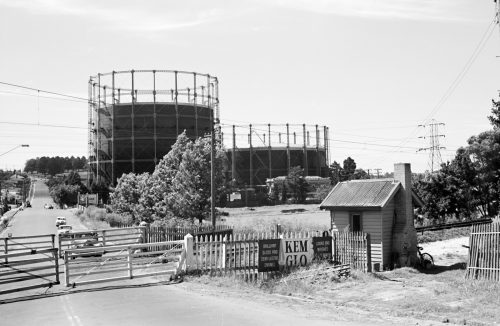
Mark Strizic photo, SLV H2008.11/960
In 1956 they were replaced by Victoria’s first set of boom barriers, operated automatically by the passage of trains.
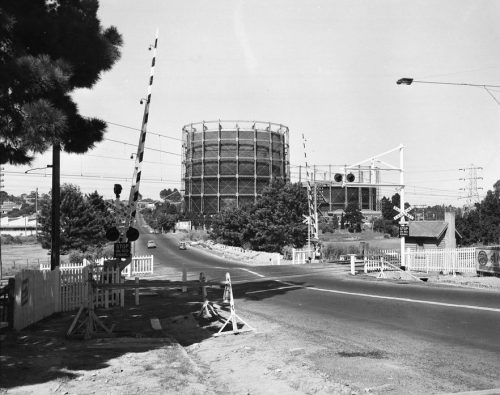
PROV photo VPRS 12800/P5 unit 27, item S0299
In 1970 the South Eastern Freeway was extended east to Toorak Road in Kooyong, where it ended at a set of traffic lights. The “missing link” between the South Eastern Freeway and the Mulgrave Freeway was eventually opened as the “South Eastern Arterial Road Link” in 1988, but in a nod to freeway objectors, was built with traffic lights at intersections instead of flyovers.
The traffic lights with the Southern Eastern Freeway at Toorak Road was replaced by a full interchange in 1996, with further freeway upgrades completed in 2000 when the CityLink project widened the road to three lanes in each direction between Toorak Road and the city, and in 2010 widened again to four lanes in each direction.
As for the level crossing, it took until February 2019 for the grade separation of Toorak Road to be announced as part of the Level Crossing Removal Project. Contracts were awarded in June 2019.
Major works started in September 2019, with a new rail over road bridge built on the west side of the existing tracks at ground level.
With trains using the new bridge from April 2020, following a nine day shutdown.
Completed bridge over Toorak Road
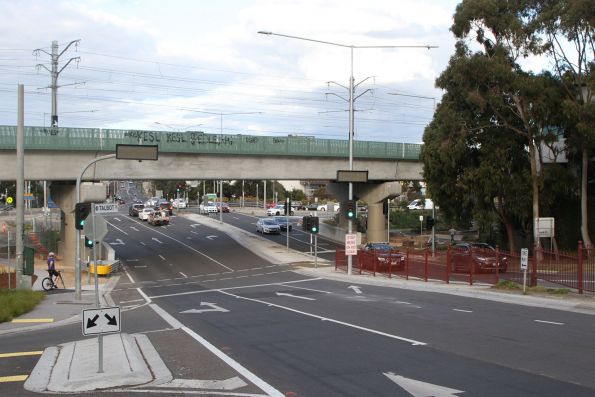
Footnote: hand gates elsewhere
Hand gates at Melbourne level crossings survived a surprisingly long time – the Upfield line was full of them until an upgrade of the line in 1997.
This left the heritage listed gates at New Street on the Sandringham line in Brighton hung on even longer.
They were “temporarily” closed in 2007, closed for good in 2010, until eventually replaced by boom barriers in 2013.
Other level crossing protection
The first automated level crossing warning system on Victoria’s railways was a ‘wig wag’ signal installed at Amess Street, North Carlton in 1923, with further 31 subsequently installed around the state.
They were followed by the first set of flashing light signals installed at the Warrigal Road level crossing in Mentone in 1932.
And those big tanks
Those big round tanks behind the level crossing – they’re called gasometers and were once used to store gas, until they were made made redundant by the rollout of natural gas – but that’s a story for another time.
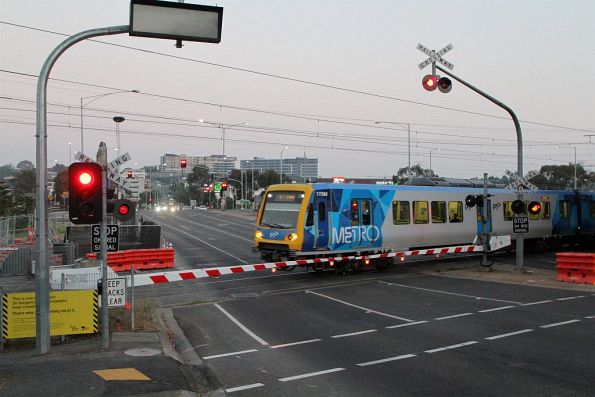
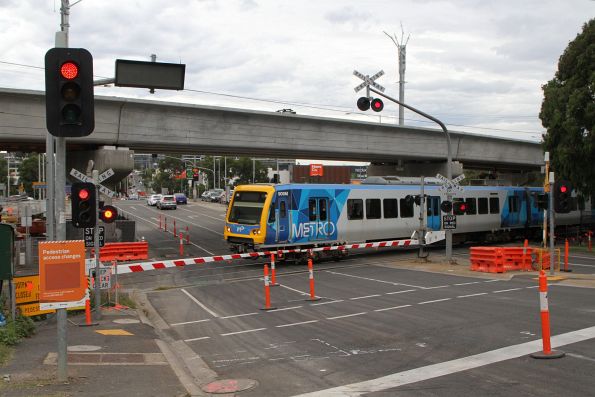
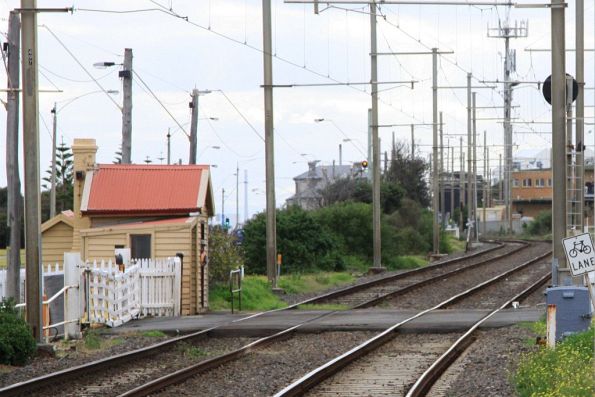
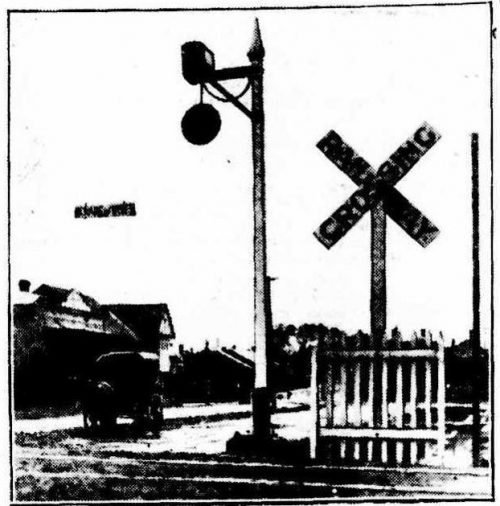

The first automatic warning systems in Victoria were automatic bells provided at four crossings on the Inner Circle (Royal Park – North Fitzroy) in 1907. These were probably Chicago Bells, made by the Railroad Supply Co of the US.
Automated crossing bells in the US dated back to the late 1870s and were installed as soon as automatic signalling became a thing. They didn’t have a good reputation until around 1900, but after that the technology rapidly improved and they were common products by around 1905. So Victoria wasn’t doing too badly introducing them in 1907.
Except for hand gates and interlocked gates, all road/rail protection in Victoria has been US technology – starting from cattle pits in the 1880s.
I presume the “mechanical interlocked boom gates” installed at McKinnon in the 1920s were European, rather than American, technology. See photo 71-16:
http://www.brownfam.com.au/ROLL71/ROLL71.htm
It is also a pity that we haven`t adopted the British style flashing lights with with a yellow flashing light, rather than the American style red only lights.
It’s interesting how the Inner Circle was the first line to get active protection – I’m guessing a combination of heavy road traffic increased the risk, but the cost of staffing conventional staffed gates couldn’t be justified for the level of rail traffic.
There is still hand gates at Tinning street, Brunswick. They are locked in place and all, but they are still there in position.
Turns out I have a photo of them. 😛
Is there a reason no decommissioned gasometres have survived in Melbourne compared to the UK where decommissioned gasometres are still abundant and sometimes heritage listed?
It’s an interesting question.
Perhaps the timing of the rollout of natural gas had something do do with it – in the 1960s historical preservation wasn’t really a thing yet, so since they were now unused and taking up space, nobody cared about them being demolished.
The other is that industrial heritage has had a hard time locally – significant places such as the Morwell Power Station have been recently demolished.
https://www.abc.net.au/news/2019-01-29/morwell-power-station-demolition-approval-process-concerns/10756124
Apparently there is only one gas holder left standing in NSW.
https://www.nationaltrust.org.au/conservation-interiors-southern-gasholder/
I am researching the wigwag warning signal that was installed by Victorian Railways at the Bluebell railway crossing on the former Ovens Valley Highway and Ovens Valley Bright Railway between Myrtleford and Gapsted.
Does anybody know when this wigwag was installed and when it was replaced with flashing red lights?
From this page, which quotes an article written by the late John Sinnatt for Somersault:
http://www.trainweb.org/dansrailpix/WIG_WAG_PAGE6_australia2.htm
Wigwag signal was installed at the Ovens Highway crossing between Gapstead and Myrtleford in 1925/1926, exact date not known.
While “Weekly Notice Extracts 1894-1994” by Alan Jungwirth and Keith Lamber says they were replaced by flashing lights in September 1950.